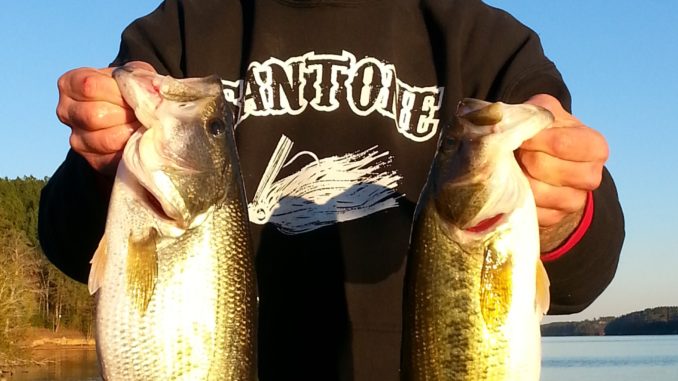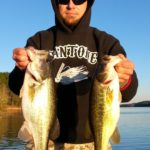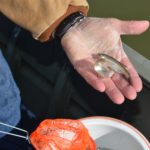
The drop-shot rig, tied for either soft-plastic lures or live bait, is a precise presentation that catches bass in cold water across the Carolinas.
The air is biting cold, and the sky is the purest shade of blue. Glenn Grindstaff of Marion, N.C., is huddled inside his thick coat. The hood is pulled well past the top of his head. The outboard chugs along at idle speed as he steers his boat across sharp-breaking points, along channel-swing banks and over deep-water flats. All the while, he’s intently watching the fish finder mounted above the helm. He can picture what he wants to see.
When he’s not hunting bigger quarry as president of the Western North Carolina Muskie Club, Grindstaff chases bass up and down the reservoirs on the Catawba River, which has its headwaters just east of Asheville and runs across the state line to South Carolina’s Lake Wateree. He has spent the most time over the past 60 years on Lake James, studying the seasonal movements of smallmouth, largemouth and spotted bass. So when winter grabs tight and water temperatures bottom out, he knows how to catch them.
Shad and alewives, found in a number of reservoirs on the Catawba River, school tightly in deep water when surface temperatures hit winter levels. They don’t stay stationary, instead hovering in the water column and randomly bouncing from one piece of structure to the next. Regardless of where they roam, bass are never far away. Catching them has historically involved fishing low and slow with grubs, jigs, jigging spoons and sometimes suspending jerkbaits or crankbaits. Umbrella rigs, aka Alabama rigs, add one more option.
You can add drop-shot rigs to that list. The technique, which involves a weight below a bait, is a bass-fishing staple during warmer months, especially where smallmouth abound. But it’s just as effective for largemouth and spots during the winter. Take the example of bass pro Aaron Martens, who used a drop-shot rig to fool enough deep-water bass to finish in the top 10 at the Bassmaster Classic on Lake Hartwell in February 2008. While he used a small soft-plastic finesse worm, a couple slight rigging changes make the drop-shot rig perfect for presenting live bait.
Both versions catch wintertime bass. On a good day, Grindstaff can catch about a dozen bass with his rig. That’s enough action to warm even the most-accomplished bass angler on a cold day. But you have to find them first.
Shane Lineberger of Lincolnton, N.C., has seen a lot during his travels to fishing spots near and far. He has won tournaments across the Southeast and will begin his second season on the Bassmaster Elite Series tournament trail this month. But he set one personal wintertime fishing record close to home.
“The deepest I have caught a bass is 81 feet on Lake Norman,” he said, “and it had mud on its belly.”
While that may be the extreme, he said, cold temperatures redefine the outer limits for bass. Finding them in 30 to 50 feet of water in winter is the norm.
Bass have reason to swim to deep water. Like heading shallow in spring, it’s a seasonal movement dictated by environmental conditions. They’re going deep to eat, plain and simple. Cold surface water — temperatures in the upper 40s and below — force most baitfish to deep water, where relatively warmer temperatures are more tolerable. They usually find it in the mouths of large creeks or the main lake. When you find baitfish, you’ll find bass, but getting there can take time. The baitfish are on the move. While they’ll stick to a region of a lake, they don’t stay still for long. You have to constantly catch up to them.
Lineberger, whose Shane’s Baits line includes an Alabama rig — Blades of Glory — turns to the GPS mapping function in his fish finder for a starting spot. He wants to see contour lines that are close together, indicating a sharp drop. Wintertime bass prefer that situation because they don’t have to travel far laterally to change depth. But outside of that, there’s no rhyme or reason to where he starts.
“Where the bait goes, that’s where they go,” he said.
Grindstaff sees that random movement, too.
“On Lake James, it seems so much clearer than it has ever been before,” he said. “They seem to be holding a whole lot deeper. And they are so concentrated it can be difficult to stay on them.”
There’s no telling where baitfish will hold on a particular day, so Grindstaff turns to the teachings of Buck Perry, the deep-water bass-fishing pioneer from Hickory, N.C., to help steer him in the right direction. Grindstaff believes bass are easier to catch when they are around a piece of cover or structure. If he’s moving down a deep bank, for example, the most-likely spot for him to find baitfish and bass is on a point. It gets better when he finds a spot on a spot, such as a stump on a point.
“Rock is really good,” he said.
The structure, which also could be a flat near a large creek or main-river channel, need not be large. Even small bumps along a channel-swing bank, for example, can hold baitfish and bass, if for only a little while.
You would have to be extremely lucky to find deep-water bass by simply blind-casting. Because they are concentrated, it’s difficult to line up the perfect cast with a moving lure such as a crankbait or Alabama rig. Instead, use your electronics and outboard or trolling motor to find and then ease over the top of them. A vertical presentation ensures your lure stays in the strike zone.
Drop-shot rigs are fished carefully in tight quarters. Once the weight hits bottom, the rod tip is gently shaken, taking and adding slack in the line. Make sure the weight stays stationary, which keeps your lure moving in a shaking, shimmying fashion. The key to getting just enough shake is using a slower-action rod. You can make the tip dance just by squeezing the handle.
Choices of soft plastics are almost endless. The most popular are 4- to 6-inch finesse worms or minnow imitators in natural and white hues. Texas-rigging isn’t necessary because of the lack of cover. Simply run the hook point through the lure’s nose once. The open point will catch bass that you don’t feel bite.
Grindstaff likes to continuously hop his weight a few inches off the bottom when using live bait. He believes it reduces the number of snags and helps him keep better contact with the bottom. It’s not as important to keep the weight stationary with this version of a drop-shot rig because the minnow is swimming on its own.
Long, bombing casts aren’t needed. You’re targeting baitfish and bass that are under or only a few feet away from the boat. Most times, dropping the rig over the side is all you need. A short pitch of a few yards will handle the rest.
Spinning outfits are typically used for drop-shot rigs because they handle light and small-diameter lines better than baitcasting tackle. But in winter, it pays to use baitcasting reels. Mashing a thumb bar is easier than flipping a bail or pulling apart wind knots with gloved hands. Plus, casting reels make it easier to adjust the amount of line you have out.
When baitfish and bass move, you can idle to find them again or keep casting, as Lineberger does, with other lures. He picks up a small white or shad-colored swimbait rigged on a jighead that he can let sink and slow-roll through the depth that he saw the school. Underspins, aka spinhead jigs, made popular again by South Carolina bass pro Casey Ashley in his 2015 Bassmaster Classic win on Lake Hartwell, serve the same purpose. And once you locate a school, you can return to vertically fishing for them.
Catching wintertime bass this way takes a lot of patience and, some days, more idling that fishing. But catching can happen quickly when you find a willing school.
“It can be some of the easiest fishing you’ll ever do,” Grindstaff said.
But like all good bass bites, this one eventually ends. Grindstaff said the first warm spell in late winter or early spring usually sends the bass toward shallow water, where they fan out to spawn.





Be the first to comment